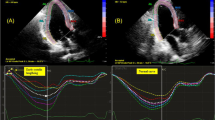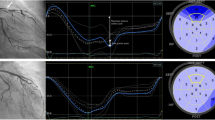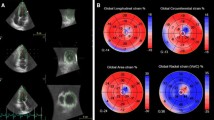Abstract
Noninvasive detection of left main/three-vessel diseases (LM/3VD) among patients with non-ST-elevation acute coronary syndromes (NSTEACS) has been difficult using echocardiography. However, two-dimensional (2D) strain/strain-rate analysis is more sensitive in quantitatively assessing contractile abnormality. Accordingly, we aimed to clarify the usefulness of 2D strain/strain-rate analysis for risk stratification of NSTEACS. A total of 50 patients with NSTEACS underwent echocardiography and coronary angiography. We evaluated global longitudinal peak strain (global PS), peak systolic strain rate (global SSR), early diastolic global peak strain rate (global ESR), time from aortic valve closure to peak strain (TAVC-global PS), and global ESR (TAVC-global ESR) in apical four-, two-, and three-chamber views. Patients were divided into two groups according to coronary angiographic findings, the high-risk group (n = 15) with either of left main or three-vessel disease, and the low-risk group (n = 35). There were no significant differences in global SSR and global ESR between the two groups. The amplitude of global PS was significantly reduced in high-risk patients with LM/3VD in comparison with low-risk patients (−17.5 ± 2.4 % vs −19.8 ± 2.7 %, P = 0.007, respectively). TAVC-global PS and TAVC-global ESR were significantly prolonged in high-risk patients with LM/3VD in comparison with low-risk patients (15.3 ± 25.7 ms vs −36.8 ± 32.7 ms, P < 0.0001 and 162.8 ± 32.7 ms vs 135.7 ± 41.5 ms, P < 0.03, respectively). Receiver-operating characteristic analysis demonstrated that TAVC-global PS most strongly detected high-risk patients with sensitivity of 100 % and specificity of 74.3 % (area under the curve = 0.938, 95 % confidence interval 0.832–0.986, P = 0.0001). Temporal analysis of 2D strain appeared to be useful in detecting high-risk patients with LM/3VD among patients with NSTEACS.



Similar content being viewed by others
References
Anderson JL, Adams CD, Antman EM, Bridges CR, Califf RM, Casey DE Jr, Chavey WE 2nd, Fesmire FM, Hochman JS, Levin TN, Lincoff AM, Peterson ED, Theroux P, Wenger NK, Wright RS, Smith SC Jr, Jacobs AK, Halperin JL, Hunt SA, Krumholz HM, Kushner FG, Lytle BW, Nishimura R, Ornato JP, Page RL, Riegel B (2007) ACC/AHA 2007 guidelines for the management of patients with unstable angina/non-ST-elevation myocardial infarction: a report of the American College of Cardiology/American Heart Association Task Force on Practice Guidelines (writing committee to revise the 2002 guidelines for the management of patients with unstable angina/non-ST-elevation myocardial infarction) developed in collaboration with the American College of Emergency Physicians, the Society for Cardiovascular Angiography and Interventions, and the Society of Thoracic Surgeons, endorsed by the American Association of Cardiovascular and Pulmonary Rehabilitation and the Society for Academic Emergency Medicine. J Am Coll Cardiol 50:e1–e157
Garcia S, Canoniero M, Peter A, de Marchena E, Ferreira A (2004) Correlation of TIMI risk score with angiographic severity and extent of coronary artery disease in patients with non-ST-elevation acute coronary syndromes. Am J Cardiol 93:813–816
Potter BJ, Dorais M, Mansour S, Orlicka K, Gobeil F, Rinfret S (2009) Effectiveness of myocardial perfusion scintigraphy to predict coronary anatomy in patients with non-ST elevation acute coronary syndrome. Am J Cardiol 104:644–647
Noda M, Takagi A, Kuwatsuru R, Mitsuhashi N, Kasanuki H (2008) Prognostic significance of multiple-detector computed tomography in conjunction with TIMI risk score for patients with non-ST elevation acute coronary syndrome. Heart Vessels 23:161–166
Stoylen A, Heimdal A, Bjornstad K, Wiseth R, Vik-Mo H, Torp H, Angelsen B, Skjaerpe T (2000) Strain rate imaging by ultrasonography in the diagnosis of coronary artery disease. J Am Soc Echocardiogr 13:1053–1064
Mele D, Pasanisi G, Heimdal A, Cittanti C, Guardigli G, Levine RA, Sutherland G, Ferrari R (2004) Improved recognition of dysfunctioning myocardial segments by longitudinal strain rate versus velocity in patients with myocardial infarction. J Am Soc Echocardiogr 17:313–321
Winter R, Jussila R, Nowak J, Brodin LA (2007) Speckle tracking echocardiography is a sensitive tool for the detection of myocardial ischemia: a pilot study from the catheterization laboratory during percutaneous coronary intervention. J Am Soc Echocardiogr 20:974–981
Kim H, Shin HW, Son J, Yoon HJ, Park HS, Cho YK, Han CD, Nam CW, Hur SH, Kim YN, Kim KB (2011) Two-dimensional strain or strain rate findings in mild to moderate diastolic dysfunction with preserved ejection fraction. Heart Vessels 26:39–45
Reisner SA, Lysyansky P, Agmon Y, Mutlak D, Lessick J, Friedman Z (2004) Global longitudinal strain: a novel index of left ventricular systolic function. J Am Soc Echocardiogr 17:630–633
Ishii K, Suyama T, Imai M, Maenaka M, Yamanaka A, Makino Y, Seino Y, Shimada K, Yoshikawa J (2009) Abnormal regional left ventricular systolic and diastolic function in patients with coronary artery disease undergoing percutaneous coronary intervention: clinical significance of post-ischemic diastolic stunning. J Am Coll Cardiol 54:1589–1597
Lang RM, Bierig M, Devereux RB, Flachskampf FA, Foster E, Pellikka PA, Picard MH, Roman MJ, Seward J, Shanewise JS, Solomon SD, Spencer KT, Sutton MS, Stewart WJ (2005) Recommendations for chamber quantification: a report from the American Society of Echocardiography’s Guidelines and Standards Committee and the Chamber Quantification Writing Group, developed in conjunction with the European Association of Echocardiography, a branch of the European Society of Cardiology. J Am Soc Echocardiogr 18:1440–1463
Fang LL, Zhang PY, Wang C, Wang LM, Ma XW, Shi HW, Feng XH (2011) Two-dimensional strain combined with adenosine stress echocardiography assessment of viable myocardium. Heart Vessels 26:206–213
Lima RS, Watson DD, Goode AR, Siadaty MS, Ragosta M, Beller GA, Samady H (2003) Incremental value of combined perfusion and function over perfusion alone by gated SPECT myocardial perfusion imaging for detection of severe three-vessel coronary artery disease. J Am Coll Cardiol 42:64–70
Kosuge M, Ebina T, Hibi K, Morita S, Komura N, Hashiba K, Kiyokuni M, Nakayama N, Umemura S, Kimura K (2009) Early, accurate, non-invasive predictors of left main or 3-vessel disease in patients with non-ST-segment elevation acute coronary syndrome. Circ J 73:1105–1110
Choi JO, Cho SW, Bin Song Y, Cho SJ, Song BG, Lee SC, Park SW (2009) Longitudinal 2D strain at rest predicts the presence of left main and three vessel coronary artery disease in patients without regional wall motion abnormality. Eur J Echocardiogr 10:695–701
Jamal F, Kukulski T, Strotmann J, Szilard M, D’Hooge J, Bijnens B, Rademakers F, Hatle L, De Scheerder I, Sutherland GR (2001) Quantification of the spectrum of changes in regional myocardial function during acute ischemia in closed chest pigs: an ultrasonic strain rate and strain study. J Am Soc Echocardiogr 14:874–884
Pislaru C, Belohlavek M, Bae RY, Abraham TP, Greenleaf JF, Seward JB (2001) Regional asynchrony during acute myocardial ischemia quantified by ultrasound strain rate imaging. J Am Coll Cardiol 37:1141–1148
Skulstad H, Urheim S, Edvardsen T, Andersen K, Lyseggen E, Vartdal T, Ihlen H, Smiseth OA (2006) Grading of myocardial dysfunction by tissue Doppler echocardiography: a comparison between velocity, displacement, and strain imaging in acute ischemia. J Am Coll Cardiol 47:1672–1682
Voigt JU, Lindenmeier G, Exner B, Regenfus M, Werner D, Reulbach U, Nixdorff U, Flachskampf FA, Daniel WG (2003) Incidence and characteristics of segmental postsystolic longitudinal shortening in normal, acutely ischemic, and scarred myocardium. J Am Soc Echocardiogr 16:415–423
Thambyrajah J, Vijayalakshmi K, Graham RJ, Turley AJ, de Belder MA, Stewart MJ (2008) Strain rate imaging pre- and post-percutaneous coronary intervention: a potential role in the objective detection of ischaemia in exercise stress echocardiography. Eur J Echocardiogr 9:646–654
Hosaka M, Takagi A, Takagi T, Ashihara K, Hagiwara N (2010) Strain measurements during adenosine triphosphate infusion before and after percutaneous coronary intervention. Circ J 74:1600–1608
Tanaka H, Kawai H, Tatsumi K, Kataoka T, Onishi T, Nose T, Mizoguchi T, Yokoyama M (2006) Improved regional myocardial diastolic function assessed by strain rate imaging in patients with coronary artery disease undergoing percutaneous coronary intervention. J Am Soc Echocardiogr 19:756–762
Chan J, Hanekom L, Wong C, Leano R, Cho GY, Marwick TH (2006) Differentiation of subendocardial and transmural infarction using two-dimensional strain rate imaging to assess short-axis and long-axis myocardial function. J Am Coll Cardiol 48:2026–2033
Author information
Authors and Affiliations
Corresponding author
Rights and permissions
About this article
Cite this article
Hoshi, H., Takagi, A., Uematsu, S. et al. Risk stratification of patients with non-ST-elevation acute coronary syndromes by assessing global longitudinal strain. Heart Vessels 29, 300–307 (2014). https://doi.org/10.1007/s00380-013-0361-y
Received:
Accepted:
Published:
Issue Date:
DOI: https://doi.org/10.1007/s00380-013-0361-y




